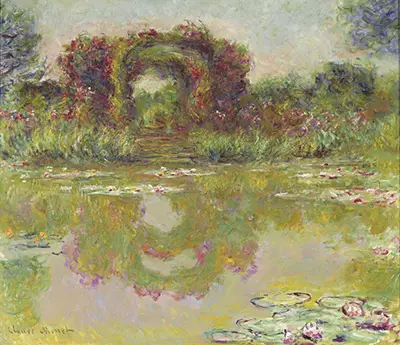The oil on canvas work known as The Rose Arches Giverny is in many ways typical of Monet's style, and this article explores three ways in which it is characteristic of his work: the fact that it was painted outdoors, the fact that it is part of a series (the whole series was painted between 1920 and 1922), and the fact that it is executed in the Impressionist style.
Claude Monet was a French Impressionist painter who was active in the second half of the 19th century and the early part of the 20th century.
This means that Monet would have been sitting or standing right in front of the rose arches as he painted them, giving his painting a very authentic and immediate flavour. Painting en plein air was a hallmark not only of Monet's individual style but also of the style of the Impressionists in general.
In order to enable them to paint outdoors in situ, they would use tubes of ready mixed paint (in lieu of dry pigments to be mixed with water on an artist's palette) and a briefcase style 'box easel' for carrying all of the paints and other materials to the painting site and then for unfolding to create an easel to work on.
The second way in which The Rose Arches Giverny is typical of Monet's style is the fact that it is not just one painting, but a series of paintings of the same rose covered archway.
This series shows how the seasons, the changing light throughout the day, and the artist's own differing thoughts and impressions are able to cast the arches in wonderfully different lights. Monet loved to paint series of objects in this revealing manner - objects as diverse as haystacks, bridges, cathedrals, and trees.
Thirdly and finally, The Rose Arches Giverny is painted - like almost all of Monet's works - in a highly impressionistic style. He focused particularly on giving an impression of light and atmosphere by working first in broad brush strokes that picked out illumination and shade. By applying the oil paint directly from the tube without blending it first with other paints, Monet ensured that the colours that he used were optimally vivid.
He then overlaid these broad brush strokes with smaller strokes to pick out details. Sometimes he waited for the lower layers to dry before he painted over them, but other times he did not. His use of dreamlike and imaginative colours, and the way in which he broke away from traditional realist depictions of the world around him are two of the key attributes that make Monet one of the central figures of the Impressionist movement.


